You know that a day offshore in foul weather can be exhilarating at first but after 30 minutes, your thoughts start to drift. “Perhaps visiting the grandchildren would have been a better idea.” You know your boat is capable and so are you and your crew. You get tired; fatigued. But nature has no “off-switch” so you battle on until things settle down. Luckily, you were wise enough to pick the right foul weather gear. You and your crew are dry and as comfortable as nature allows you to be.
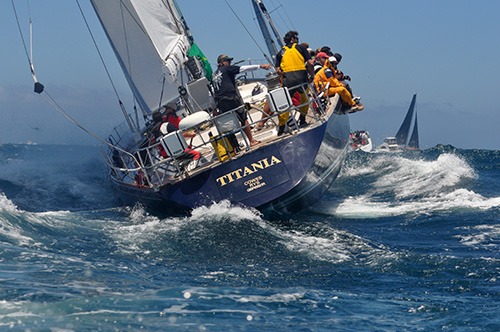
What is foul weather gear?
The first thing to consider is the fact that a jacket is foul weather gear but foul weather gear is not just a jacket. It often includes overalls type trousers. Both are water and windproof and “breathable” and are often rated coastal, off-shore or ocean denoting their purpose. We refer to the foul weather jacket and trousers as our “foulies”. Furthermore, foul-weather clothing often consists of three layers.
- The base layer (in essence, your underwear): it acts as a wick and draws sweat away from your skin.
- The middle layer (this insulates you): it retains your body heat and protects you from the cold.
- The outer layer (your foulies): it shields you from wind, rain, and saltwater.
In this review, we will be focusing on the “outer layer” and the foul weather offshore jacket only.
What to look for in foul weather jackets?
Waterproof fabric
That seems logical but the term “waterproof” is, in fact, a little bit more complex than it appears. If water does not pass through a fabric, then we can say that the fabric is “waterproof” but a 100% waterproof fabric (or material) is not necessarily best. A 100 mm rubber layer is close to waterproof but has an exceptionally low wearability rating unless your name is the Michelin Man. So, there will always be a trade-off between comfort (manoeuvrability) and waterproofing. Another reason not to use your 100 mm thick rubber fabric is the fact that there is a good possibility that you will get wet anyway; from the inside-out. Your sweat needs to be able to escape and hence your fabric needs to be breathable (see the next point; breathability).

In sailing, different situations call for different solutions so it is no surprise then that the techos have developed fabrics on a scale ranging from shit to really, really awesome. After their first meeting, they did decide that the scale title needed improving so they renamed it the “Hydrostatic Head Scale” (expressed in mm). With this scale in mind, we can now go to the shop and compare jackets with jackets and purchase something that suits our purpose. Let us have a look at the scale that determines how waterproof your jacket is.
Hydrostatic Head (mm) | Water Resistance | Usable Conditions |
0-5,000 mm | No resistance to some resistance to moisture. | Light rain, dry snow, no pressure. |
6,000-10,000 mm | Rainproof and waterproof under light pressure. | Light rain, average snow, light pressure. |
11,000-15,000 mm | Rainproof and waterproof except under high pressure. | Moderate rain, average snow, light pressure. |
16,000-20,000 mm | Rainproof and waterproof under high pressure. | Heavy rain, wet snow, some pressure. |
20,000 mm+ | Rainproof and waterproof under very high pressure. | Heavy rain, wet snow, high pressure. |

Okay, I can hear you ask “mm???”. I was coming to that… Here we go, stay with me because this is getting a bit technical (boring in fact). If you take your fabric and seal one site of a 1.27-inch round pipe (or a 1-inch square tube) with your fabric then, voila; you are looking at your testing kit. Now for argument sake, imagine your pipe is 200 meters long, is vertically orientated with the fabric sealing off the bottom. Now you are ready to start your “how waterproof is my jacket” test. If you fill your pipe up with water to the 5,000 mm mark (5 meters) and the fabric lets no water through then you can say that your fabric is rated equal or better than 5,000 mm. If you fill your pipe up to the 20,000 mm mark (200 meters) and no water leaks, then your fabric is rated at least 20,000 mm or more. So there you go again saying “I don’t have a 200-meter pipe!” Luckily, some people with a better understanding of maths figured out that you can also apply 1 PSI to the fabric which equates to 704 mm on the above scale. Enough!
When you are in the market for an off-shore or ocean rated jacket you can now ask the shop assistant what the jacket’s Hydrostatic rating is rather than using the old “shit to really, really awesome” scale.
Breathable fabric
Most quality foul weather jackets are made from breathable fabrics. These fabrics resist liquid passing through but allow vapour to pass through. So breathable fabrics block out rain and saltwater while allowing vapour from sweat to escape.
Having a highly breathable jacket may not be necessary if you are the owner of a super-yacht and only need to wink at the waiting staff for a top-up of your G&T. If you are at the helm in choppy conditions or working like a bow-monkey then you may need to think about a higher level of breathability for your jacket.
Ironically, the techos developed a scale for this as well. Originally termed the same as the original waterproof scale, they amended the title to simply “Breathability Scale” expressed as g/m2/24h. I.e., the number of grams of water vapour moving through a square meter of fabric from the inside to the outside in a 24 hour period. For example, take a 10k (10,000 g/m2) fabric, this would be 10,000 grams of moisture transfer. The greater the figure, the more breathable the fabric.
So now we can rate our jacket for both waterproofness and breathability. Below are 3 random examples of fabric:
Brand | Waterproofness (mm) | Breathability (g/m²/24hr) |
GORE-TEX Pro 3L | >28,000 | 25,000 |
PERTEX Shield+ 2.5L | 20,000 | 20,000 |
Ventia 2.5L | 10,000 | 10,000 |
Nooooo… Are we now also introducing litres? Do not panic. 3L means 3 layers.
Layers
We are almost there… Waterproof jackets (or other similar products) often come in 2, 2.5 or 3 layers.
2 layers simply indicate that the fabric consists of an outer layer which focuses on the ecstatic of the jacket and an inner layer which functions as the waterproof layer. Often, the outer layer is coated with “Durable Water Repellency” (DWR). DWR enables water to bead on your jacket and just rolls off. Unfortunately, DWR wears off after use and losses its effectiveness over time. However, 2 layered jackets are flexible and cheaper and good for light weather conditions.
2.5 layers is similar to a 2 layered fabric. The 0.5 refers to a sprayed on partly shielding layer that sits in between the 2 layers. 2.5 layered jackets are most commonly used in raincoats.
3 layered material expands on the 2.5 layered fabric by replacing the 0.5 with a Polytetrafluoroethylene (try saying that after a Long Island Iced Tea) or simply PTFE) membrane. This film is sandwiched between a tough outer and often nylon or mesh inner layer. It offers maximum protection from the elements.
Naturally, it does not stop there. It would have been easier if they just stopped there but some manufacturers prefer to use IP codes which indicate the “International Protection” marking. However, I can’t be bothered to explain it as it usually doesn’t relate to clothing. But as an example, IP06 means that the product is protected from high-pressure water jets from any direction.
Seam tape

Last thing about waterproof fabric. Jackets have seams where fabric is sewn together. Sewing requires puncturing your beautiful waterproof fabric with little holes and as we know, nothing leaks like a hole; just ask dear liza… So, most quality jacket manufacturers apply a waterproof tape where there is a seam. This tape is often glued and can be applied to all seams or those seams determined by the manufacturer as critical. Off-shore and ocean classed jackets are normally fully taped.
Style
There is a great range of jackets available for both the men and women. In the last few years, a more stylish fit developed for female sailors that not only looks good but has practical differences such as shorter sleeves and tailored waist etc…
You get what you pay for
Disregard the cheapest brands. Often they are made from non-breathable materials and will last as long as halfway through their first event.
Saying this, don’t be intimidated by the more expensive brand’s techno waffle either. Dixinophas (R), 6 layered Dynicon breathable fabric with composite membrane lamination may sound great but words don’t keep you dry… Try to find some peer reviews to determine how satisfied previous customers were with not only the product but also with the (after-sales) service.
Look for features that you need
All manufacturers try to differentiate themselves from others by including features that may or may not be useful to you.
Do you need a large visor on your hood? Can you fold the hood away and is it adjustable? Is the collar high enough? Look at safety features such as reflectors, gear pockets, EPIRB sleeves, etc… Does the jacket have adjustable shoulders and waist? Attachment for safety lines…
Dry Suits vs. Foulies
Like our foulies, a dry suit is a “shell” to keep out rain, wind, and seawater. In general, we can see some similarities between dry suits and foulies:

- Drysuits do not offer insulation against the cold so it requires a layered clothing system as described earlier.
- They are made from durable, waterproof, and breathable materials.
However, there are differences between your foulies and dry suits:
- A dry suit comes in one piece. Often, your drysuit includes waterproof socks attached to the suit.
- It has seals at the neck and wrists (and ankles if no socks are attached) made of either natural rubber latex rubber or neoprene for the purpose of sealing out water.
- Drysuits are harder to get in and out of and therefore often have zippers in strategic places to facilitate toilet breaks.
- Drysuits extend the survival time in cold water.
In general, I prefer foulies over dry suits but there were times where I thought otherwise. If you are on a bowsprit and the boat is falling off a wave, then don’t be surprised if the force of the water is so great that it will shoot up the inside of your jacket and shoots out with equal force from the collar; you have to love it…
Foul Weather Gear - Fit for Purpose
Different situations call for different solutions. This principle is true for choosing your foul weather gear. Maximising your comfort (or minimising your discomfort) is underpinned by matching your gear with the situation you will find yourself in. Generally, there are different classifications we can use to steer us in the right direction when purchasing our foul weather gear. Often used classifications include:
- Rivers and Lakes
- Inshore
- Coastal
- Off-shore
- Ocean
Lets have a look at these in more detail…
Rivers and Lakes
- The jacket looks more like a conventional “rain jacket”.
- A waterproof and breathable 2 layer material and or a DWR coating.
- If at all, it comes with a very light fold-away hood.
- The jacket comes down to the hip.
- Often zippers are exposed.
- Low collar for maximum maneuverability.
- No adjustment.
- Pants are on the hip for light protection.
- No safety features such as fluorescent reflectors.
- Trousers are often one-size-fits-all.
- Generally used in light weather.
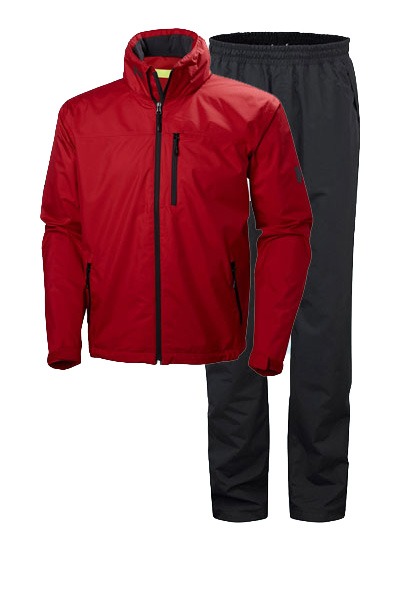
In-shore
- The jacket and pants are starting to look like foul weather gear.
- A waterproof and breathable 2 or 2.5 layer material with DWR coating.
- It usually comes with a hood that may have some adjustment.
- The jacket comes down under the hip for more protection.
- Often zippers are protected.
- Higher collar with velcro adjustment for a tighter seal against water penetration.
- Introducing some reflective tape for MOB safety.
- Pants have a bib for better protection.
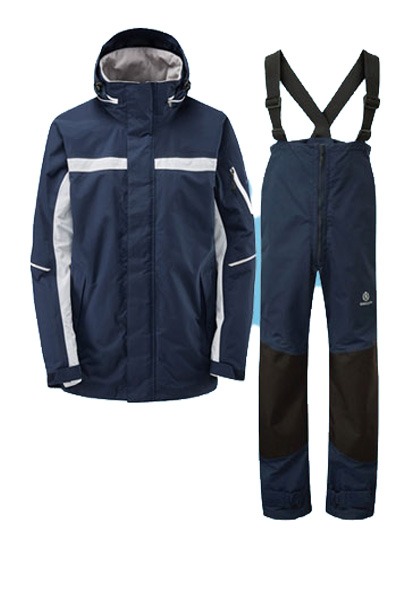
Coastal
- The jacket is now purpose-designed for sailing.
- A waterproof and breathable 2, 2.5 or 3 layer material.
- It has a hood that is adjustable with reflective tape and potentially a firm visor.
- The jacket is longer and may have an extended back for when sitting.
- Zippers are protected.
- Higher collar with velcro adjustment.
- Reflective tape for MOB safety.
- Introducing pockets for specific equipment.
- Pockets are still general use but some inner purpose pockets may be introduced to secure specific gear.
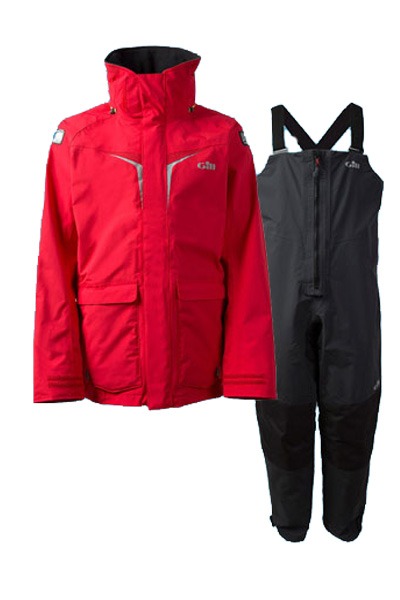
Off-shore
- The jacket sole purpose is to protect against wind, rain, and seawater.
- Often 3 layer material such as Gore-Tex or similar brands.
- Hood is adjustable with a firm visor with a potential gutter to drain water away.
- The jacket comes down lower and the pants are higher for additional protection.
- Zippers are protected often by multiple layers of fabric and seams are taped.
- High collar with optional storm-shield.
- A more roomy cut to allow additional thermal layers for protection against cold.
- Dedicated pockets for EPIRB and other safety gear.
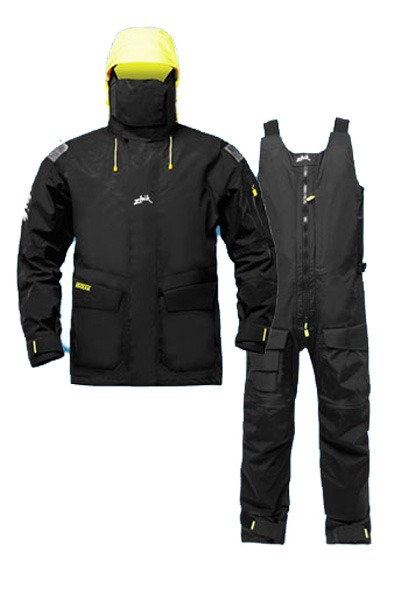
Ocean
- The jacket is designed for maximum protection for prolonged periods of time.
- The hood is adjustable at the sides and from the back to increase sealing out moister whilst maintaining visibility.
- Sleeves have inner and outer wrist seals to minimise moisture running down the arms when working above head-height.
- The jacket comes down further and the bib is higher for maximum protection.
- All zippers are protected with multi-layered fabric to seal openings.
- Maximum height collars with storm-shields to protect against waves.
- Loose fit to allow additional thermal layers for protection against cold.
- Specialised pockets for safety gear like personal EPIRB and other tools.
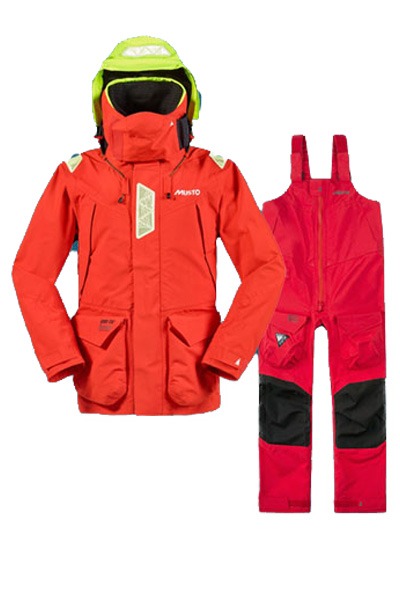
Happy and safe sailing…
If the article was helpful then don’t be afraid to share it on social media. Also, we love to hear from you so leave a comment below…
